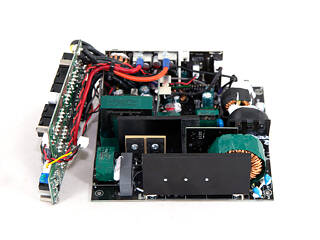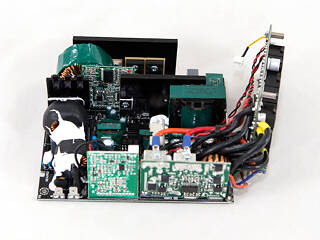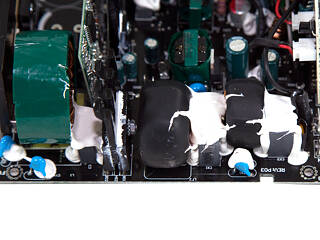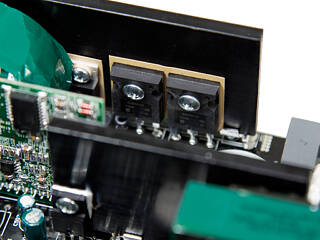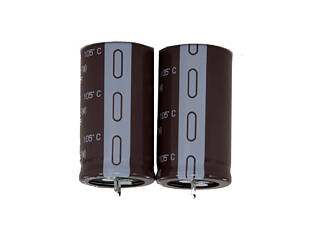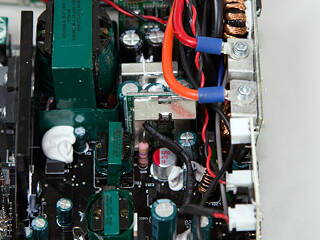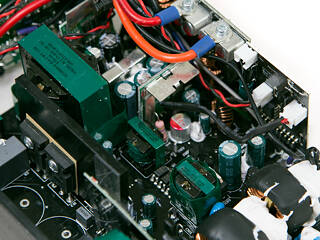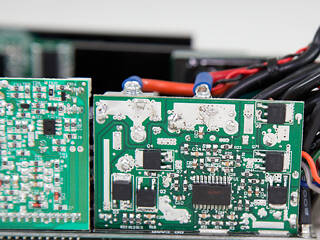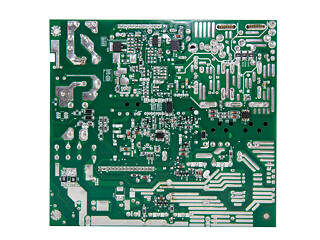 17
17
Corsair RM Series 1000 W Review
Voltage Regulation, Hold-up Time & Inrush Current »A Look Inside & Component Analysis
Before reading this page, we strongly suggest a look at this article, which will help you understand the internal components of a PSU much better. Our main tool for the disassembly of the PSU is a Thermaltronics TMT-9000S soldering and rework station. It is of extreme quality and is equipped with a matching de-soldering gun. With such equipment in hand, breaking apart every PSU is like a walk in the park!| Corsair RM1000 Parts Description | |
|---|---|
| Primary Side | |
| Transient Filter | 6x Y caps, 2x X caps, 2x CM chokes, 1x MOV |
| Bridge Rectifier(s) | 2x GBJ1506 |
| APFC Mosfets | 2x Vishay Siliconix SIHG30N60E |
| APFC Boost Diode | 1x SCS110AG |
| Hold-up Cap(s) | 2x Nippon Chemi-Con (400V, 390uF each, 105°C, KMR) |
| Main Switchers | 2x Vishay Siliconix SIHG30N60E |
| APFC Controller | Infineon ICE3PCS01G - CM03X |
| Switching Controller | Infineon ICE2HS01G |
| Topology | Half Bridge |
| Secondary Side | |
| +12V | 3x International Rectifier 7004 C239P 3x International Rectifier 7004 C240P |
| 5V & 3.3V | DC-DC Converters: 6x M3006D fets PWM Controller: uP3861P |
| Filtering Capacitors | Electrolytics: Taicon, CapXon Polymers: Apaq, Enesol |
| Supervisor IC | Weltrend WT7502 |
| Fan Model | NR135L (12 V, 0.22 A, rifle bearings) |
| 5VSB Circuit | |
| Rectifying Diode | STPS2045CTC |
| Standby PWM Controller | - |
CWT (Channel Well Technology) is this RM unit's OEM, and the same company builds nearly every other RM model. As mentioned, the RM850 and RM750 units are by Chicony. This platform, however, is very different and more advanced since it uses an LLC converter in the primary side for lossless switching and increased efficiency. The secondary side uses the for a modern PSU typical DC-DC converters for the generation of the minor rails, along with a synchronous design for the generation of the +12V rail. The relatively small and finless heatsinks for a PSU of this capacity are odd. We would have liked beefier heatsinks because of the unit's semi-passive operation.
The first part of the transient filter is on the AC receptacle and includes a pair of Y caps. The other components, two pairs of Y caps, a pair of X caps, two CM chokes, and an MOV, are on the main PCB. There is also an NTC thermistor for inrush protection, and its corresponding relay can be found near the APFC's converter.
The two parallel bridge rectifiers with model number GBJ1506 can handle up to 30 A of current, which makes them strong enough for this PSU.
The APFC converter utilizes two Vishay Siliconix SIHG30N60E fets and an SCS110AG boost diode. Both bulk caps are provided by Nippon Chemi-Con (400V, 390uF each or 780uF combined, 105°C, KMR series).
The APFC controller, an Infineon ICE3PCS01G, and a CM03X Green PFC controller are installed on a vertical daughter-board right next to the APFC's choke. The same board also contains the resonant controller, an Infineon ICE2HS01G IC.
Two Vishay Siliconix SIHG30N60E fets act as main switchers and are most likely arranged in a half-bridge topology. We also found an STF3NK80Z fet, which the 5VSB circuit probably uses, on the same heatsink.
There are no actual heatsinks in the secondary side, but the +12V fets are installed on vertical boards, and two bus bars not only transfer power but also help in cooling the fets down. This is a typical design for a modern CWT implementation; however, we don't know how effective of a solution it is for a semi-passive, high capacity PSU. Only time will tell whether it is reliable, but Corsair seems confident enough as they do provide a five year warranty. The six aforementioned fets are provided by International Rectifier, and their model numbers, in a fifty-to-fifty split, are 7004 C239P and 7004 C240P.
All caps except for a single polymer cap on the main board in the secondary are electrolytic, and every single cap is either by Taicon and CapXon, two Taiwanese companies. They are of decent quality and more affordable but inferior to Japanese caps.
The supervisor IC, a Weltrend WT7502 with only the basic protections, has been installed on the other side of this small PCB.
Both DC-DC converters are on this PCB. The PWM controller for both is an uP3861P IC, and each VRM uses three M3006D fets. As you can see, two very thick wires transfer power to the modular PCB.
Many cables go to the rear of the modular board.
On the modular PCB are a mixture of Apaq and Enesol polymer caps for some extra ripple filtering and several electrolytic caps by CapXon.
Soldering quality on the main PCB is pretty good, and we noticed three shunt resistors under the +12V area, so this PSU could have three +12V rails instead of one with a suitable supervisor IC.
The cooling fan is, according to Corsair, designed to operate quietly. This fan's model number is NR135L (12 V, 0.22 A), and it uses a rifle bearing, an improved sleeve bearing.
Jan 8th, 2025 21:04 EST
change timezone
Latest GPU Drivers
New Forum Posts
- Are people planning an upgrade? (13)
- All RTX 5090s only have 1x 16-pin connector (39)
- What are you playing? (22540)
- Help me understand the direction of VR and its decisions (7)
- Technical Issues - TPU Main Site & Forum (2024) (505)
- NVIDIA has revealed the prices for the RTX 5090, 5080 and 5070 (153)
- Flashing 4090 MSI Ventus 3x E OC (1)
- AMD Phenom II X6 1090T - Upgrade AM4 / AM5 / Intel Advice - Keep the 1080ti. (33)
- TPU's Nostalgic Hardware Club (19756)
- Overclocking My System Advice for CPU, RAM, and GPU (26)
Popular Reviews
- ASUS ROG Strix B850-F Gaming WiFi Review
- AMD Ryzen 7 9800X3D Review - The Best Gaming Processor
- DDR5 Thermal Testing & Analysis
- GPU Test System Update for 2025
- Call of Duty: Black Ops 6 Performance Benchmark Review - AMD FTW
- Upcoming Hardware Launches 2024 (Updated Nov 2024)
- SCYROX V8 Review
- Intel Arc B580 Review - Excellent Value
- Klevv Genuine G560 2 TB Review
- HEDDphone TWO GT Air Motion Transformer Headphones Review
Controversial News Posts
- NVIDIA 2025 International CES Keynote: Liveblog (434)
- AMD Debuts Radeon RX 9070 XT and RX 9070 Powered by RDNA 4, and FSR 4 (318)
- NVIDIA GeForce RTX 5090 Features 575 W TDP, RTX 5080 Carries 360 W TDP (208)
- AMD Radeon RX 9070 XT Alleged Benchmark Leaks, Underwhelming Performance (204)
- Potential RTX 5090 and RTX 5080 Pricing in China Leaks (173)
- 32 GB NVIDIA RTX 5090 To Lead the Charge As 5060 Ti Gets 16 GB Upgrade and 5060 Still Stuck With Last-Gen VRAM Spec (173)
- AMD Radeon RX 9070 XT Boosts up to 3.10 GHz, Board Power Can Reach up to 330W (167)
- NVIDIA GeForce RTX 5070 Ti Leak Tips More VRAM, Cores, and Power Draw (161)


